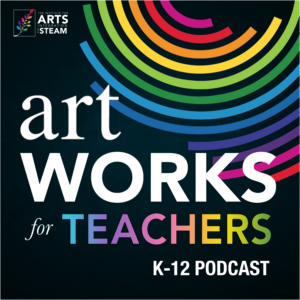ART WORKS FOR TEACHERS PODCAST | EPISODE 109 | 25:43 MIN
3 Frames for Creative Teaching
Enjoy this free download of the 3 Frames for Creative Teaching resource.
Here in Maryland, we’ve had our first big cold snap. So that has meant a lot of time getting our home ready for winter. Putting our deck chairs away, blowing off leaves, and bringing in anything fragile. And while I hate seeing the warmth of summer fade away, there is a stillness that comes in the chill of winter. To be honest, I’m not great with quiet. I actually worry a great deal in the winter. I know deep down that things will all be okay, but there is something about the dormancy and quiet of winter that unsettles me. Do you ever feel that way? I’m trying to learn to embrace the winter as a time when we recover and repair. But that’s difficult.
I think that’s why today’s topic of the 3 Frames for Creative Teaching is exciting to me. As a teacher, I always found the holiday season to be both joyous and stressful in schools. Students have a long winter ahead of them with a lot of intense work. And we’ve just turned the corner of 1st quarter and getting settled in for the ride. Now, we throw in the holiday season and virtual/hybrid teaching and our students need an outlet more than ever before. They’re getting antsy and classroom management becomes a challenge. And we have all of the regular stressors of school, plus making sure we order our gifts so they arrive on time. We don’t have the energy to try and make something engaging.
If that sounds familiar, then you’re going to love these 3 frames I’m going to share today. Think of these as a handy set of options that you can pull out of your bag of teaching tricks and immediately get students focused in a new way. Let’s dive in!
3 Frames for Creative Teaching Overview
Now I’m going to let you in on a little secret: these frames don’t come from the world of education. They are actually sales and persuasion frames that marketers use to sell us products. BUT, what I’ve discovered is that they work really well to encourage divergent and creative thinking in the classroom.
Also, these frames are simple – I don’t want you to overcomplicate things here. They are each built on one single question. The elegance is in the simplicity. Remember: these are frames. They aren’t hard and fast rules. Imagine that what I share today are the boundaries that you set, but the students have a lot of freedom to make the picture inside the frame anything they want.
List of Frames Discussed:
- The Contrast Frame
- The Less is More Frame
- The Empty Chair Frame
As we go over these frames, think about how you might be able to use each in your class individually as well as possibly layering them together. I think you’ll find so much flexibility with these and have fun being creative in how you use them.
The Contrast Frame
The contrast frame is all about anchoring your idea. There is one simple question you’ll have students consider “compared to what?”. This is a powerful question that leads students to position their idea as a contrast to something that’s already available. This is a great way to get students considering why their idea or solution is valuable. It’s also a good way to begin a lesson through question and answers.
For example, let’s say you begin class by sharing with students that you’ll make a statement and their only job is to reply back with “compared to what?” Then, you begin with a statement like “This pandemic is the worst thing to happen in a generation.” And they respond, “Compared to what?”. You could respond with “Compared to the economic recession that happened in 2008”. This then becomes a point of discussion: is it really worse than that? Are there other events that are more important or that shaped us differently than the pandemic? You can model this for a while and then flip the tables. Have students create a statement about a topic or event and then your only response is “compared to what?”.
This does a few things:
- it encourages students to consider their idea, statement, or topic as a whole rather than in isolation.
- It helps students to anticipate objections or clarify their point of view
- It helps anchor position statements and offers an entry point to discussion
You can use this to discuss art, music, politics, mathematical theories, point of view in literature – almost anything.
As author Dan Pink points out, “we tend to overvalue addition and undervalue subtraction”. In this frame, we’re looking for students to remove everything extraneous until we are left with the essentials of their work. Lots of artists and writers use this frame when editing their work.
The key question for this frame is “what can you release?”. Lots of times, when we create something, we want it to include everything we have to say. So our work becomes cluttered and muddy. This frame gives students an opportunity to let go of things that aren’t absolutely essential to the work and if they choose to keep something, to have solid evidence behind that choice.
I also really like the word “release” instead of “remove”. Removing feels like you have to take something away that was important. Release is more freeing and feels more like a shedding of something that doesn’t serve the purpose. Sometimes this can refer to releasing an argument or it could be releasing a student’s own preconceptions.
How you can use this frame:
- When editing a composition (with traditional or non-traditional mediums)
- When working on a reflection or artist’s statement
- When trying to persuade or having civil discourse
- When problem-solving for an unknown
The Less is More Frame
As author Dan Pink points out, “we tend to overvalue addition and undervalue subtraction”. In this frame, we’re looking for students to remove everything extraneous until we are left with the essentials of their work. Lots of artists and writers use this frame when editing their work.
The key question for this frame is “what can you release?”. Lots of times, when we create something, we want it to include everything we have to say. So our work becomes cluttered and muddy. This frame gives students an opportunity to let go of things that aren’t absolutely essential to the work and if they choose to keep something, to have solid evidence behind that choice.
I also really like the word “release” instead of “remove”. Removing feels like you have to take something away that was important. Release is more freeing and feels more like a shedding of something that doesn’t serve the purpose. Sometimes this can refer to releasing an argument or it could be releasing a student’s own preconceptions.
How you can use this frame:
- When editing a composition (with traditional or non-traditional mediums)
- When working on a reflection or artist’s statement
- When trying to persuade or having civil discourse
- When problem-solving for an unknown
The Empty Chair Frame
The Empty Chair Frame is the one most commonly used in business, but that I think is the most powerful one for teachers and administrators. You can certainly use it with students, but I have found this most useful in my planning meetings and when considering difficult decisions.
In the empty chair frame, you set up seats for everyone in your meeting. If it’s just you, have your own seat ready. Then, pull out an empty chair and place it at the table for the most important person: the one that you’re making decisions FOR. In a planning meeting, this might be a chair for the student. In an administrative meeting, it might be a chair for the parent. Then, consider the point of view of the person who that seat is reserved for in your meeting and ask the question “how would this person respond if…?”
For example, if you’re making a decision about where to place a child next year, and the empty chair is for the parent, ask the question “how would this child’s parent respond if the child was placed here?”
This immediately re-centers your conversation and decision-making around the person most affected by that decision. Students can use this frame in the classroom if they are working on a STEM, STEAM, or PBL project where they must create a new solution. Or, if they are creating a piece of artwork, considering the audience they are creating it for.
Key ideas:
- Use this frame during the creation or decision making process. It’s meant to be an active part of the process, not just a consideration of the final product.
- Give yourself space to adjust based on what the empty chair representative might say, think, or do. The question “how would this person respond if…” is meant to provoke and agitate your thinking surrounding the idea. Be open to changing it if necessary.
Okay…now that we’ve had a chance to explore these 3 frames, consider how you might use each one either in your classroom, or in your life in some way. And, even better, think about how you might layer some of these frames. Consider when these might be most helpful to your teaching practice and for your students. I have heard so many teachers share in frustration over the past few months that students are just not engaging or are disinterested in digging below surface level answers. I hope that these frames help to shake up their thinking and get them moving forward in more critical and creative ways.









